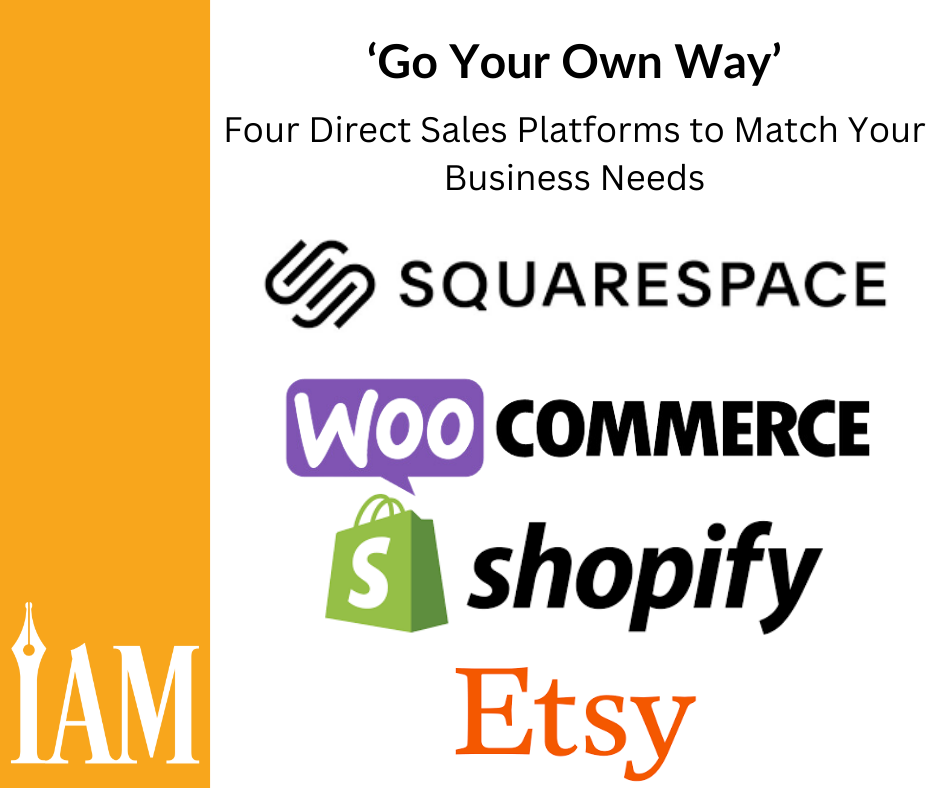Four Direct Sales Platforms to Match Your Business Needs
Jenn Lessmann
The “Rumours” are true. Indie authors can earn more revenue and drive better engagement through direct sales. And as indie authors increasingly look to expand their reach through wide publication, it makes sense to consider following Fleetwood Mac’s call to “go your own way.”
You might not be ready to break up with Amazon yet, but if you’re looking for a more open relationship, maybe it’s time to set aside that bully romance for more of a “why choose” option. Going direct—selling books through their own distribution channels, such as through their author website or in person—brings some authors the control they crave.
The best part is that it doesn’t have to be an all-or-nothing shift in your business plan. Keep reading to explore a few of the ways you can add direct sales to your existing author business.
You want to have a store, but you don’t want to build it: Etsy
For authors looking to dip a toe into direct sales without learning a new platform, Etsy offers an easy first step. It’s similar to Amazon in that it doesn’t require much setup beyond loading in your products, and to a certain extent, it’s a marketplace with a built-in customer base. People are already going there to shop, so author marketing is less about convincing readers to buy and more about convincing them to choose your book over other products the Etsy algorithm shows them.
The standard plan has no monthly charges, and you can upgrade to Etsy Plus and get more features for $10 per month. However, Etsy has so many sales fees that people have developed third-party calculators to help sellers track them. For example: every new listing, or re-listing of a sold product, costs twenty cents, every order carries a 6.5 percent transaction fee, and payment processing fees are 3 percent plus twenty-five cents per transaction.
Keep in mind that you will also need to account for order fulfillment, whether you choose to purchase your books in bulk and mail them out yourself or integrate a print-on-demand service like Lulu Direct, BookVault, or TheBookPatch.com.
An author with a smaller catalog, who is willing to part with some of their profit in order to have someone else handle taxes, calculate shipping, and provide secure transactions, might do well starting with Etsy. Authors can even link their Etsy shop with Squarespace or Shopify as their business grows.
Forbes recently compared Shopify and Etsy in more detail.
You want to design and run your own store: Shopify
Shopify is widely considered the easiest e-commerce platform. Its customization features provide so many options that some users, like best-selling Romance author Jillian Dodd, have completely replaced their traditional websites with a Shopify store. Shopify also integrates with WordPress, Squarespace, and Wix, so you don’t have to let go of your home base to get started.
Unlike Etsy, Shopify charges a monthly subscription fee, in addition to transaction fees when you make a sale. They offer three tiers at $29, $79, and $299 per month. The lowest tier is the most popular, and probably more than enough for most authors starting out in direct sales. According to Shopify’s sales page, at this level, you get “everything you need to create your store, ship products, and process payments.” The higher tiers allow for more staff accounts and more customized reports.
Users cite customer support, ease of customization, and data collection as reasons to switch to Shopify. Although Etsy allows customers to “favorite” your shop and products, the marketplace doesn’t collect customer emails. On Shopify, customers can opt in at checkout, allowing you to follow up with marketing newsletters and store updates. Buyers can save their information so they don’t need to re-enter it when making purchases from another Shopify store, making Shop Pay payments as trusted as Google Pay or Apple Pay.
You can also get the best of both worlds by integrating your Etsy shop with Shopify. The Shopify app will synchronize with Etsy in real time to avoid confusion, letting you update listings on either app to take advantage of Etsy’s marketplace audience.
If you want to use the Shopify point-of-sale without building a store, the Shopify Starter Plan—formerly Shopify Lite—costs $15 per month and provides product pages, checkout, Inbox, and Linkpop. You might miss the Basic Plan’s features, like theme editing and blog posts, but the Starter Plan is a quick way to get direct sales up and running on your mobile website, email campaigns, or social media.
Joanna Penn has discussed the ways she uses Shopify with her WordPress site extensively on her podcast, The Creative Penn. She recently spoke with Thomas Umstaddt Jr. of The Novel Marketing Podcast about the details of selling and marketing direct. While they primarily cover Shopify and its many integrations, they also compare Payhip, Gumroad, and Kickstarter as options for first-time authors.
You want to add direct sales to your existing WordPress website: WooCommerce
An alternative to creating your store on a separate website, WooCommerce is a standard plugin available for paid WordPress accounts that allows you to process sales on your existing author website. It’s open source, which allows for customization but also means you might find bugs or integration problems.
WooCommerce is free to use if you already have a WordPress site, but you won’t have Shopify’s customer service to support you, and some themes and integrations will have additional fees.
The WordPress Business or Commerce plans that allow these types of plugins cost $25 or $45 per month. WordPress offers more features and customization than most authors will ever need but requires more technical knowledge to manage well.
Ultimately, adding WooCommerce to an existing site gives you fewer setup fees and more control than Etsy but doesn’t provide the support and features of Shopify.
If you’re looking for a more detailed side-by-side look at the two, Jason Hamilton compared WooCommerce and Shopify for Kindlepreneur in July 2023.
You’re not using WordPress, but you’d like to run direct sales through your author website: Wix/Squarespace
Both Wix and Squarespace offer commerce plans that have sales features built into their website designers. Wix is best known for being user-friendly and easy to design, while Squarespace has a reputation for responsible growth and a people-first philosophy.
Wix provides basic e-commerce at their Core Plan level for $27 per month. Business ($32 per month) and Business Elite ($159 per month) plans offer additional features. Building the shop is easy because of drag-and-drop design tools. It connects to payment gateways like PayPal, Stripe, and Square, as well as its own Wix Payments option, with no transaction fees.
Squarespace offers fully integrated e-commerce at a 3 percent transaction fee with its Business Plan for $23 per month, or you can upgrade to a Commerce Plan for either $27 or $49 per month with no transaction fees, depending on whether you require basic or advanced features. The primary difference is that the advanced plan offers features to improve shipping, allow discounts, and sell subscriptions. All three plans allow unlimited products, courses, memberships, and videos on demand. The Commerce plans sync with Square so that you can sell in-person through your website and track sales, inventory, and customers with the same analytics as your online sales. The Commerce plans also allow you to collect and display reviews, sell through Facebook and Instagram, and use advanced merchandising features.
Wix and Squarespace both integrate with drop-shipping companies like Printful and Printify to make fulfillment of some products easier. You may need a third-party service to integrate your book printer. Lulu currently only integrates directly with Woo, Shopify, and Lulu API. However, BookVault now integrates with Wix directly.
Both Wix and Squarespace have email campaign features that allow you to sync your store with your newsletter, making the websites a one-stop shop for most of your customer-facing author business needs.
Other Options to Consider
If you’re not using one of the previously mentioned hosts, check and see if your current website builder has e-commerce features. Moving to direct sales may just be a matter of upgrading your current hosting plan.
For example, GoDaddy has e-commerce features available. Using a managed WordPress with WooCommerce store, GoDaddy claims to have the lowest fees at 2.3 percent plus thirty cents per transaction. The managed website plan starts at $19.99 per month.
E-commerce platforms like Payhip, Gumroad, and Stan Store allow you to build a store without managing a blog or author website. They’ll have bigger fees per sale but no monthly cost. Initially developed for digital creators, these options work best for authors with strong social media presences.
Alternatively, social media platforms Facebook, Instagram, and TikTok all have marketplaces. Even the subscription platform Ream has plans to incorporate direct sales stores for its members in the future.
Pro Tip: IngramSpark is about to launch Share & Sell, a program that will provide you with shareable purchase links you can use to send readers directly to IngramSpark from your website, social media, or business cards. Visit https://ingramspark.com/e-commerce-beta-sign-up to participate in the beta release before the program launches in 2024.
Whether you choose to manage your own merchandise or make use of on-demand services, creating your own store is the next logical step for authors who don’t want to depend on retailers. As Fleetwood Mac sings, “Open up. Everything’s waiting for you.”
Jenn Lessmann










